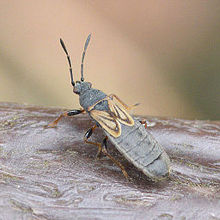Blissidae
| Blissidae | |
|---|---|
 | |
| Ischnodemus sabuleti | |
| Scientific classification | |
| Domain: | Eukaryota |
| Kingdom: | Animalia |
| Phylum: | Arthropoda |
| Class: | Insecta |
| Order: | Hemiptera |
| Suborder: | Heteroptera |
| Infraorder: | Pentatomomorpha |
| Superfamily: | Lygaeoidea |
| Family: | Blissidae Stål, 1862[1] |
The Blissidae are a family in the Hemiptera (true bugs), comprising nearly 50 genera and 400 species.[2] The group has often been treated as a subfamily of the Lygaeidae but was resurrected as a full family by Thomas Henry (1997).[3]
The adult insects are elongate, typically four times as long as broad, and in some species, up to seven times. Short wings are common in many species.
All the species feed on the sap of plants, mostly grasses, and most of the species live between the sheaths of leaves.[2] The most economically important species is the true chinch bug, Blissus leucopterus, a destructive pest of corn crops in the United States.
List of genera
These 54 genera of the family Blissidae are listed in the Lygaeoidea Species File:[4][2]
- Aradacrates Slater & Wilcox, 1969
- Aradademus Slater, 1967
- Archaeodemus Slater, 1986
- Atrademus Slater, 1967
- Aulacoblissus Slater, 1986[5]
- Australodemus Slater & Sweet, 1963
- Barademus Slater, 1967
- Barrerablissus Brailovsky, 2015
- Blissiella Slater, 1967
- Blissus Burmeister, 1835 (chinch bugs)
- Bochrus Stal, 1861
- Capodemus Slater & Sweet, 1972
- Cavelerius Distant, 1903
- Caveloblissus Slater & Wilcox, 1968
- Chelochirus Spinola, 1839
- Dentisblissus Slater, 1961
- Dimorphopterus Stal, 1872
- Extarademus Slater & Wilcox, 1966
- Extaramorphus Slater, Ashlock & Wilcox, 1969
- Gelastoblissus Slater & Wilcox, 1969
- Hasanobochrus Ghauri, 1982
- Heinsius Distant, 1901
- Heteroblissus Barber, 1954
- Howdenoblissus Stys, 1991[6]
- Iphicrates Distant, 1904
- Ischnocoridea Horvath, 1892
- Ischnodemus Fieber, 1837
- Lemuriblissus Slater, 1967
- Lucerocoris Slater, 1968
- Macchiademus Slater & Wilcox, 1973
- Macropes Motschulsky, 1859
- Merinademus Slater, 1967
- Micaredemus Slater, 1967
- Napoblissus Brailovsky & Barrera, 2012[7]
- Patritiodemus Slater & Ahmad, 1971
- Patritius Distant, 1901
- Pirkimerus Distant, 1904
- Praeblissus Barber, 1949
- Praetorblissus Slater, 1966
- Procellademus Slater & Wilcox, 1966
- Propinquidemus Slater, 1986
- Pseudoblissus Slater, 1979
- Ramadademus Slater, 1967
- Reticulatodemus Slater & Wilcox, 1966
- Riggiella Kormilev, 1949
- Scansidemus Slater & Wilcox, 1969
- Scintillademus Slater, 1968
- Slaterellus Drake & Davis, 1959
- Spalacocoris Stal, 1874
- Talpoblissus Slater & Wilcox, 1973
- Toonglasa Distant, 1893[8]
- Tympanoblissus Dellapé & Minghetti, 2020
- Wheelerodemus Henry & Sweet, 2015
- Xenoblissus Barber, 1954
References
- ^ Stål, C. (1862). "Synopsis Coreidum et Lygaeidum Sueciae". Öfversigt Af Kongliga Vetenskaps-Akademiens Förhandlingar. 19. p. 212.
- ^ a b c Slater, J.A. (1979). "The systematics, phylogeny, and zoogeography of the Blissinae of the world (Hemiptera, Lygaeidae)". Bulletin of the AMNH. 165 (1): 1–180. hdl:2246/1076.
- ^ Henry, T.J. (1997). "Phylogenetic analysis of family groups within the infraorder Pentatomomorpha (Hemiptera: Heteroptera), with emphasis on the Lygaeoidea". Annals of the Entomological Society of America. 90 (3): 275–301. doi:10.1093/aesa/90.3.275.
- ^ Dellapé, Pablo M.; Henry, Thomas J. (2021). "family Blissidae Stål, 1862". Lygaeoidea Species File. Retrieved 2021-10-04.
- ^ Slater, J.A. (1986). "Aulacoblissus, a New Genus of Micropterous Blissinae from Venezuela (Hemiptera: Lygaeidae)". Florida Entomologist. 69 (4): 661–665. doi:10.2307/3495210. JSTOR 3495210.
- ^ Štys, P. (1991). "First apterous genus and species of Lygaeidae: Blissinae (Heteroptera)". Acta Entomologica Bohemoslovaca. 88 (3–4): 265–271.
- ^ Brailovsky, H.; Barrera, E. (2012). "A remarkable new Micropterous Blissidae (Hemiptera, Heteroptera, Lygaeoidea) from South America". Deutsche Entomologische Zeitschrift. 59 (1): 43–45.
- ^ Slater, J.A.; Brailovsky, H. (1983). "Review of the Neotropical Genus Toonglasa (Hemiptera, Lygaeidae)" (PDF). Annals of the Entomological Society of America. 76 (3): 523–535. doi:10.1093/aesa/76.3.523. Archived from the original (PDF) on 2014-12-22. Retrieved 2014-12-16.
External links
 Media related to Blissidae at Wikimedia Commons
Media related to Blissidae at Wikimedia Commons Data related to Blissidae at Wikispecies
Data related to Blissidae at Wikispecies
- v
- t
- e
- Kingdom: Animalia
- Phylum: Arthropoda
- Class: Insecta
- Subclass: Pterygota
- Infraclass: Neoptera
- Superorder: Paraneoptera
Suborder Auchenorrhyncha | |||||||||||||
|---|---|---|---|---|---|---|---|---|---|---|---|---|---|
| |||||||||||||
Suborder Sternorrhyncha | |||||||||||
|---|---|---|---|---|---|---|---|---|---|---|---|
| |||||||||||
| |||||||||||||||||||||||||||||||||||||||||||||||||||||||||||||
 | This Lygaeoidea article is a stub. You can help Wikipedia by expanding it. |
- v
- t
- e











